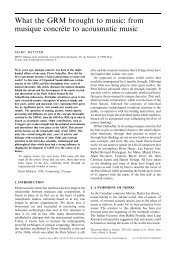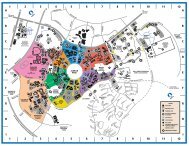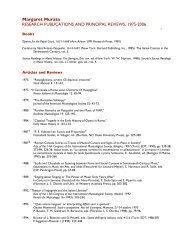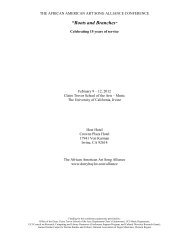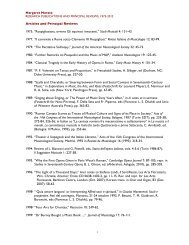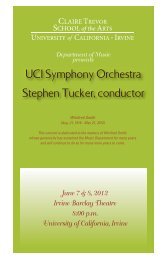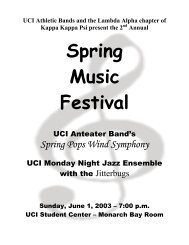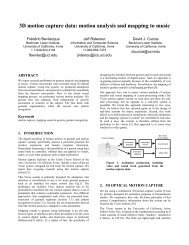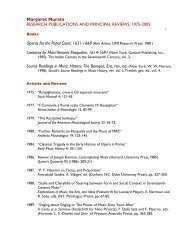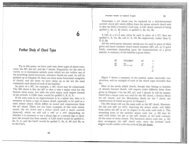amy bauer The Other of the Exotic: Balinese Music as Grammatical ...
amy bauer The Other of the Exotic: Balinese Music as Grammatical ...
amy bauer The Other of the Exotic: Balinese Music as Grammatical ...
You also want an ePaper? Increase the reach of your titles
YUMPU automatically turns print PDFs into web optimized ePapers that Google loves.
<strong>The</strong> <strong>O<strong>the</strong>r</strong> <strong>of</strong> <strong>the</strong> <strong>Exotic</strong> 341<br />
vaguely E<strong>as</strong>tern even while conforming in design and intent to <strong>the</strong> Western<br />
model <strong>of</strong> a cl<strong>as</strong>sical étude. Fur<strong>the</strong>rmore, just <strong>as</strong> <strong>the</strong> music works on different<br />
levels <strong>of</strong> meaning, so its title is a perhaps unintended pun, Barong being <strong>the</strong> name<br />
<strong>of</strong> <strong>the</strong> beloved protector-dragon <strong>of</strong> <strong>Balinese</strong> myth which dances to <strong>the</strong> music <strong>of</strong><br />
<strong>the</strong> gamelan at major festivals. 12<br />
Although <strong>the</strong> Étude does not relate specifically to any particular work in <strong>the</strong><br />
<strong>Balinese</strong> repertory, it compares in a number <strong>of</strong> ways to <strong>the</strong> dynamic gong kebyar<br />
style. Gong kebyar is <strong>the</strong> dominant secular gamelan idiom <strong>of</strong> modern Bali and is<br />
characterised by extreme virtuosity, sudden and dr<strong>as</strong>tic changes <strong>of</strong> mood,<br />
dynamics and tempo and an intricate precomposed design. <strong>The</strong> varied rhythms,<br />
articulations and pedallings <strong>of</strong> ‘Galamb borong’ echo <strong>the</strong> twenty or more percussion<br />
instruments <strong>of</strong> <strong>the</strong> gong kebyar orchestra (which may also include a<br />
stringed rebab and an end-blown bamboo flute called a suling). Ex. 1 is a<br />
representation <strong>of</strong> one cycle <strong>of</strong> a traditional dance, ‘Baris’, <strong>as</strong> transcribed by<br />
Michael Tenzer in approximate Western notation from a recorded performance<br />
by <strong>the</strong> gamelan ensemble <strong>of</strong> <strong>the</strong> Sekolah Tinggi Seni Indonesia (College <strong>of</strong> Arts)<br />
in Denp<strong>as</strong>ar, Bali. 13 Here low-voiced bronze gongs and b<strong>as</strong>s metallophones<br />
(jegogan) anchor <strong>the</strong> colotomic, or cyclic, structure <strong>of</strong> <strong>the</strong> composition, while<br />
mid-voiced metallophones (ugal and calung) form <strong>the</strong> body <strong>of</strong> <strong>the</strong> kebyar orchestra,<br />
which performs <strong>the</strong> pokok, or core melody, at a pace two or four times f<strong>as</strong>ter<br />
than that established by <strong>the</strong> b<strong>as</strong>s instruments. High-pitched metallophones<br />
(gangsa) and tuned gongs (polos and sangsih), led by paired drums with interlocking<br />
rhythmic patterns, embellish <strong>the</strong> whole at a pace four to eight times f<strong>as</strong>ter<br />
than that <strong>of</strong> <strong>the</strong> pokok, and two to four times f<strong>as</strong>ter than that <strong>of</strong> <strong>the</strong> neliti (<strong>the</strong> lead<br />
melody, usually twice <strong>the</strong> rate <strong>of</strong> that <strong>of</strong> <strong>the</strong> pokok).<br />
Sound <strong>as</strong> Syntax in ‘Galamb borong’<br />
Most contemporary kebyar works are composed in five-note modes drawn from<br />
<strong>the</strong> pelog, a scale <strong>of</strong> seven notes separated by unequal intervals. <strong>The</strong>se are not<br />
modes in <strong>the</strong> Western sense <strong>of</strong> <strong>the</strong> term; only <strong>the</strong> general intervallic size between<br />
adjacent notes identifies <strong>the</strong> ‘key’ <strong>of</strong> a gamelan, for each set <strong>of</strong> instruments is<br />
tuned to a unique standard. 14 Paired tuning and interlocking elaboration are <strong>the</strong><br />
most distinctive signifiers <strong>of</strong> <strong>Balinese</strong>, <strong>as</strong> opposed to Javanese, gamelan. Each<br />
metallophone in a <strong>Balinese</strong> gamelan is partnered with ano<strong>the</strong>r which is tuned<br />
slightly higher or lower, though with <strong>the</strong> same intervallic content.This creates an<br />
audible tremolo – acoustic beats – when <strong>the</strong> same pitch is struck simultaneously<br />
on each member <strong>of</strong> <strong>the</strong> pair. One gangsa struck alone is dead; it is this fluctuating<br />
sound or ombak that brea<strong>the</strong>s life into <strong>the</strong> gamelan. 15<br />
Ligeti’s tonal and harmonic language <strong>of</strong>fers a kind <strong>of</strong> equal-tempered variant<br />
<strong>of</strong> such <strong>Balinese</strong> tunings. <strong>The</strong> right hand takes <strong>the</strong> ‘odd’ whole-tone scale <strong>of</strong><br />
G–A–B–D♭–E♭–F, while <strong>the</strong> left hand is restricted to <strong>the</strong> ‘even’ whole-tone scale<br />
<strong>of</strong> C–D–E–G♭–A♭–B♭. By <strong>as</strong>signing a different whole-tone scale to each hand,<br />
Ligeti intensifies <strong>the</strong> ‘paired tuning’ effect generated by <strong>the</strong> semiquaver groups<br />
which ornament <strong>the</strong> core melody. <strong>The</strong> rich, highly stratified timbre <strong>of</strong> <strong>the</strong><br />
<strong>Music</strong> Analysis, 27/ii-iii (2008)<br />
© 2009 <strong>The</strong> Author.<br />
Journal compilation © 2009 Blackwell Publishing Ltd.



